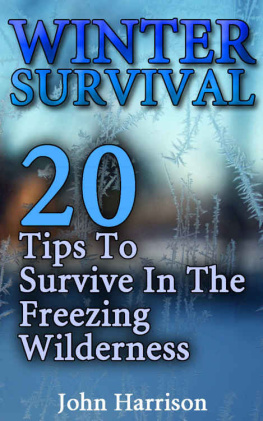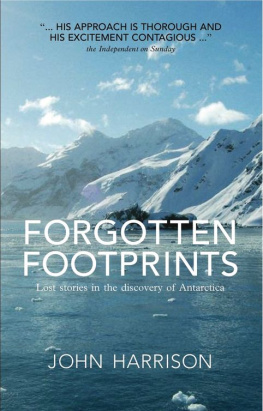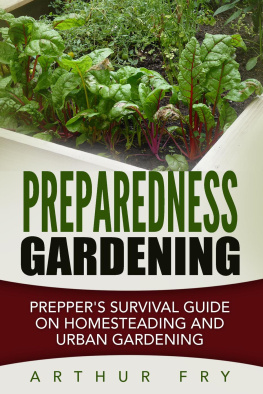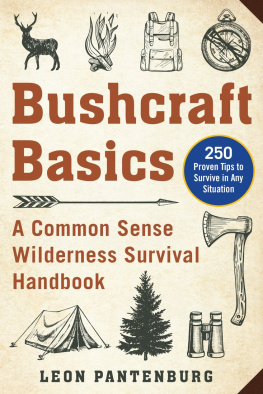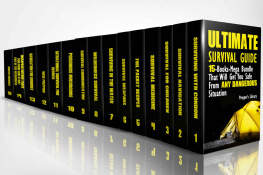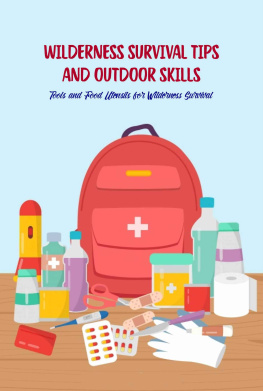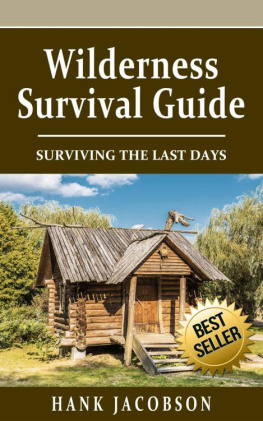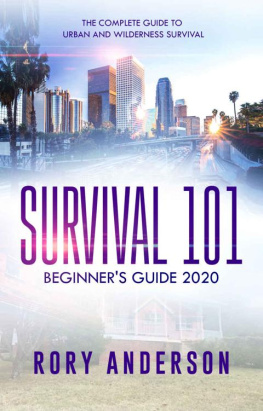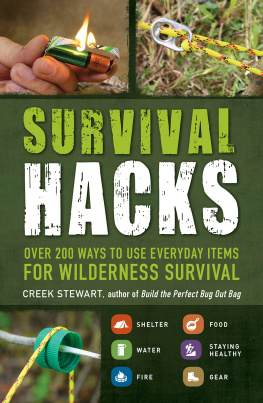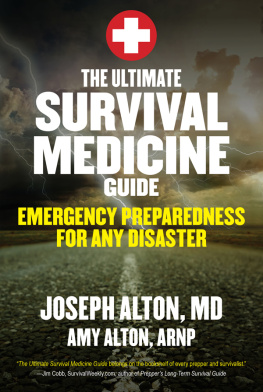Harrison - Winter Survival: 20 Tips To Survive In The Freezing Wilderness: (Preppers Guide, Survival Guide, Alternative Medicine, Emergency)
Here you can read online Harrison - Winter Survival: 20 Tips To Survive In The Freezing Wilderness: (Preppers Guide, Survival Guide, Alternative Medicine, Emergency) full text of the book (entire story) in english for free. Download pdf and epub, get meaning, cover and reviews about this ebook. year: 2016, genre: Home and family. Description of the work, (preface) as well as reviews are available. Best literature library LitArk.com created for fans of good reading and offers a wide selection of genres:
Romance novel
Science fiction
Adventure
Detective
Science
History
Home and family
Prose
Art
Politics
Computer
Non-fiction
Religion
Business
Children
Humor
Choose a favorite category and find really read worthwhile books. Enjoy immersion in the world of imagination, feel the emotions of the characters or learn something new for yourself, make an fascinating discovery.
- Book:Winter Survival: 20 Tips To Survive In The Freezing Wilderness: (Preppers Guide, Survival Guide, Alternative Medicine, Emergency)
- Author:
- Genre:
- Year:2016
- Rating:3 / 5
- Favourites:Add to favourites
- Your mark:
- 60
- 1
- 2
- 3
- 4
- 5
Winter Survival: 20 Tips To Survive In The Freezing Wilderness: (Preppers Guide, Survival Guide, Alternative Medicine, Emergency): summary, description and annotation
We offer to read an annotation, description, summary or preface (depends on what the author of the book "Winter Survival: 20 Tips To Survive In The Freezing Wilderness: (Preppers Guide, Survival Guide, Alternative Medicine, Emergency)" wrote himself). If you haven't found the necessary information about the book — write in the comments, we will try to find it.
Winter Survival: 20 Tips To Survive In The Freezing Wilderness: (Preppers Guide, Survival Guide, Alternative Medicine, Emergency) — read online for free the complete book (whole text) full work
Below is the text of the book, divided by pages. System saving the place of the last page read, allows you to conveniently read the book "Winter Survival: 20 Tips To Survive In The Freezing Wilderness: (Preppers Guide, Survival Guide, Alternative Medicine, Emergency)" online for free, without having to search again every time where you left off. Put a bookmark, and you can go to the page where you finished reading at any time.
Font size:
Interval:
Bookmark:
Winter Survival:
20 Tips To Survive In The Freezing Wilderness
Disclamer: All photos used in this book, including the cover photo were made available under a Attribution-ShareAlike 2.0 Generic (CC BY-SA 2.0)
and sourced from Flickr
Copyright 2016 by publisher - All rights reserved.
This document is geared towards providing exact and reliable information in regards to the topic and issue covered. The publication is sold with the idea that the publisher is not required to render accounting, officially permitted, or otherwise, qualified services. If advice is necessary, legal or professional, a practiced individual in the profession should be ordered.
- From a Declaration of Principles which was accepted and approved equally by a Committee of the American Bar Association and a Committee of Publishers and Associations.
In no way is it legal to reproduce, duplicate, or transmit any part of this document in either electronic means or in printed format. Recording of this publication is strictly prohibited and any storage of this document is not allowed unless with written permission from the publisher. All rights reserved.
The information provided herein is stated to be truthful and consistent, in that any liability, in terms of inattention or otherwise, by any usage or abuse of any policies, processes, or directions contained within is the solitary and utter responsibility of the recipient reader. Under no circumstances will any legal responsibility or blame be held against the publisher for any reparation, damages, or monetary loss due to the information herein, either directly or indirectly.
Respective authors own all copyrights not held by the publisher.
The information herein is offered for informational purposes solely, and is universal as so. The presentation of the information is without contract or any type of guarantee assurance.
The trademarks that are used are without any consent, and the publication of the trademark is without permission or backing by the trademark owner. All trademarks and brands within this book are for clarifying purposes only and are the owned by the owners themselves, not affiliated with this document.
Table of content
Introduction
There is something to be said for preparation. See, surviving outdoors in not an easy task. There are so many things that we take for granted and assume w e ll have access to. The mobile signals, for instanc e while within city limits, w e re never short on signals, the same cannot be said for the wild. Once yo u re out in the no-signal zone, your chances of obtaining immediate help drop immensely. Make that winter and yo u re in the worst muck ever.
So, not only do you need to be ready whenever yo u re planning for a trip to the wilderness, you need to take pre-cautions with the weather and its associated elements in mind.
W e ll begin by reviewing what we know about winter,common concerns associated with it and why preparation is necessary when yo u re taking a trip outdoors. Then, w e ll move on to the practical tips yo u re going to need when yo u re out in the open.
Winter is the coldest season, and consists of shorter days and longer nights. Winter may be mild in some temperate areas but in polar regions, it heralds the arrival of snow and below-freezing-point temperatures.
Humans are susceptible to cold. Common health issues associated with winter include flu, hypothermia and seasonal affective disorder. In snowy areas, the issues of snow-blindness may arise, along with slipping on ice or getting injured by falling icicles.
Preparation does not ensure we will not have any problems but it will ensure we have resources available at hand and significantly up your chances of survival. With that established, we can move on to the 20 tips you need to survive the wild winter.

You may be wondering what the Maslo w s pyramid has to do with survival kits.
I ll explain.
At the bottom of the pyramid lie the physiological needs: food, water, shelter and warmth. The pyramid indicates which needs have to be addressed before we can move on to the next. So, the physiological needs are the ones necessary for survival.
So, we can divide the survival tips under these four heads: Food, Water, Shelter and Warmth.
And the survival kit you prepare needs to contain things which can help address these needs. It should be prepared prior to travelling. It is something to help us tide over in case of emergencies, to have some handy essentials with us.
The items which should go into your survival kit, while covering the basics, should be customized to your plans. So consider this: what type of environment are you going in? Are you going to be hiking or trekking most of the way? Are you travelling by car? I m going to go out a limb here and assume that when going out in the wild, we enjoy being on foot.
This means that our kit needs to be handy enough to be easily carried, around 25 to 30 % of their body weight in a backpack. It needs to be light and filled only with the basics. Instead of being elaborate, the survival kit needs to be practical and stick to the basics.
Keep the most important items in a place tha t s reachable at all time s our own body. Since there is only so much we can carry on our person so, if the items w e re carrying are multifunctional, tha t s even better.
That does not mean, however, that you should not prepare a kit. It is best if you choose a case or first-aid kit or anything that suits your needs: it should be durable, waterproof and easy to carry.
So, from what Maslow said: four basic need of food, water, warmth and shelter. In that order, our kit should contain items meant for:
- Fire
- Water
- Food
- Shelter
Additionally, look at the needs right above the physiological one s yep, need for safety. So, to address those needs, w e ll have items which are meant for:
- First aid
- Signaling
Le t s proceed.
Perhaps the biggest concern in the winter wilderness is staying warm. The good thing is that you do n t have to worry and can always stop and make a fire to warm yourself up. The fire in this case will serve multiple purposes: keep you warm, cook food and melt snow to provide water.
You can carry matches, tinder, lighters, flints or even some fuel, or high quality burners. The reason for this is that you do n t know what kind of situation are you going need to light a fire in. Sometimes, lighters stop working due to cold; the matches may get damp etc. So it is best to have a back-up plan. One smart solution to that is to pack a magnifying glass. The magnifying glass will concentrate the light on a single spot and the heat is sufficient enough to set it on fire.
Yes, w e ve all seen how they rubdry sticks together and it burns or how, if you hit two pebbles, i t ll spark. But honestly, how many of us have actually tried doing it and succeeded? So, its best if you can learn to make a fire without resorting to matches or lighters. Practice makes perfect.
Carry some paper with you. This can serve as fuel for the fire and help get it going. It can be anything from toilet paper, newspaper, notebooks or anything else. Make sure to have some handy.
In winter landscape, there is always some debris available and dry sticks serve as excellent kindling. If the wood is hard and brittle and snaps off cleanly, i t ll burn. If it breaks but leaves splinters behind and not a clean break, then i t s not good and will smoke a lot without burning. Do not use wood lying in the snow because i t ll be damp; instead look in the lower branches of the trees.
Font size:
Interval:
Bookmark:
Similar books «Winter Survival: 20 Tips To Survive In The Freezing Wilderness: (Preppers Guide, Survival Guide, Alternative Medicine, Emergency)»
Look at similar books to Winter Survival: 20 Tips To Survive In The Freezing Wilderness: (Preppers Guide, Survival Guide, Alternative Medicine, Emergency). We have selected literature similar in name and meaning in the hope of providing readers with more options to find new, interesting, not yet read works.
Discussion, reviews of the book Winter Survival: 20 Tips To Survive In The Freezing Wilderness: (Preppers Guide, Survival Guide, Alternative Medicine, Emergency) and just readers' own opinions. Leave your comments, write what you think about the work, its meaning or the main characters. Specify what exactly you liked and what you didn't like, and why you think so.

